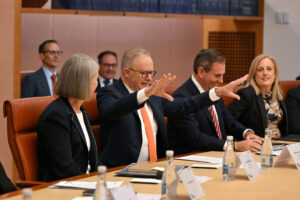After three long weeks of election campaigning neither the Prime Minister nor the Treasurer has explained how the $48 billion centrepiece of their “economic plan” will be funded. Sure, they love being asked about it, as such questions allow them to say “jobs and growth” a lot. But the actual answer is yet to pass their lips.
Luckily, Treasury’s two sets of modelling released on budget night gives us some pretty big hints about how the corporate tax cuts will be funded and why the Prime Minister refuses to answer straight questions with straight answers. Let’s start with the simple stuff.
Treasury conducted its own modelling of the tax cuts and commissioned some more from Chris Murphy’s Independent Economics and both exercises make clear that big cuts to the corporate tax rate will not be funded by “jobs and growth” but by “bracket creep and spending cuts”. How’s that for an “economic plan”.
Minimal impact on economy
At its heart, a macroeconomic model is little more than an algebraic map of the interconnections between different parts of the economy. When wages rise people usually spend more; and models are based on assumptions about how much. When people spend more, firms make more stuff and put their prices up; and models assumes how much.
Unfortunately for the Coalition, even the modelling conducted by Treasury expects that cuts to the corporate tax rate will have a very small impact on GDP and employment. Indeed it shows that the massive corporate tax cuts will cause some small increase in employment (0.1 per cent in 20 years), wages growth (up less than 0.1 per cent per annum) and GDP growth (0.05 per cent per annum). Whoops.
But the bigger problem for the government is what the modelling shows about the budget. Because Treasury concedes that a big cut in corporate tax will only have a tiny impact on the Australian economy, there is not much of a “growth dividend” for the budget. In fact, the Independent Economics modelling suggests that of the $8.2 billion per year cost of the corporate tax cuts only around $1 billion will be returned to the government’s coffers as a result of increased economic activity.
So where will the other $7.2 billion or so per year come from? In the absence of any clear statement from the Coalition we can only rely on the modelling they have released, and the answers are as unlikely as they are politically embarrassing.
‘Morality dividend’
According to the Murphy modelling, around $3.9 billion of the $7.2 billion revenue shortfall will come from the voluntary decision of multinational companies to engage in less profit shifting. This “morality dividend” is by far the largest saving measure he identifies and while I have major problems with the plausibility of his estimate, I can’t fault his transparency. Page 1 of the summary of his report makes reference to the significance of reducing profit shifting and he states clearly that “the reduction in profit shifting from the company tax cut reduces payments abroad by around $4 billion”.
While the Treasury and Murphy modelling assume that big corporate tax cuts will generate only small increases in economic activity, only the Murphy modelling assumes that half of the lost revenue will be made up via a voluntary reduction in profit shifting by multinationals. It’s akin to assuming that if a shop drops their prices, there will be a reduction in the level of shoplifting.
Regardless of the size of the “morality dividend” that is assumed, both the Treasury and Murphy modelling concludes that personal taxes will need to rise or government spending will need to be cut to fill the hole left by the corporate tax cuts. Neither modelling exercise finds that additional revenue associated with increased “jobs and growth” will even touch the sides of the budget problems the corporate tax cuts will cause.
Which brings us back to the campaign and the fact that we have five weeks still to run. There has been no cost-benefit analysis conducted by the Coalition to support their claims that, of all the way to spend $48 billion, cutting the corporate tax rate provides the best bang for the buck.
What evidence the government has released shows that the only way to make the corporate tax cuts budget neutral is via an outbreak of corporate philanthropy, big personal tax increases or big spending cuts. Turnbull’s renowned communication skills have allowed him to avoid the simple question of how his “plan” will be funded. Time will tell if he can get away with it for another five weeks.
Related documents
Between the Lines Newsletter
The biggest stories and the best analysis from the team at the Australia Institute, delivered to your inbox every fortnight.
You might also like
10 reasons why Australia does not need company tax cuts
1/ Giving business billions of dollars in tax cuts means starving schools, hospitals and other services. Giving business billions of dollars in tax cuts means billions of dollars less for services like schools and hospitals. If Australia cut company tax from 30% to 25% this would give business about $20 billion in its first year,
Economic round table recycles broken ideas
A genuine debate about how to boost Australia’s productivity should bring in a wide range of groups to talk about a wide range of options, but, alas, that’s not what happened in Canberra last week.
Company tax cuts would do little to boost investment and hurt everyday Australians – new analysis
When Treasurer Jim Chalmers brings the nation’s economic leaders together next month, don’t be surprised if big business pushes – yet again – to cut the company tax rate.


